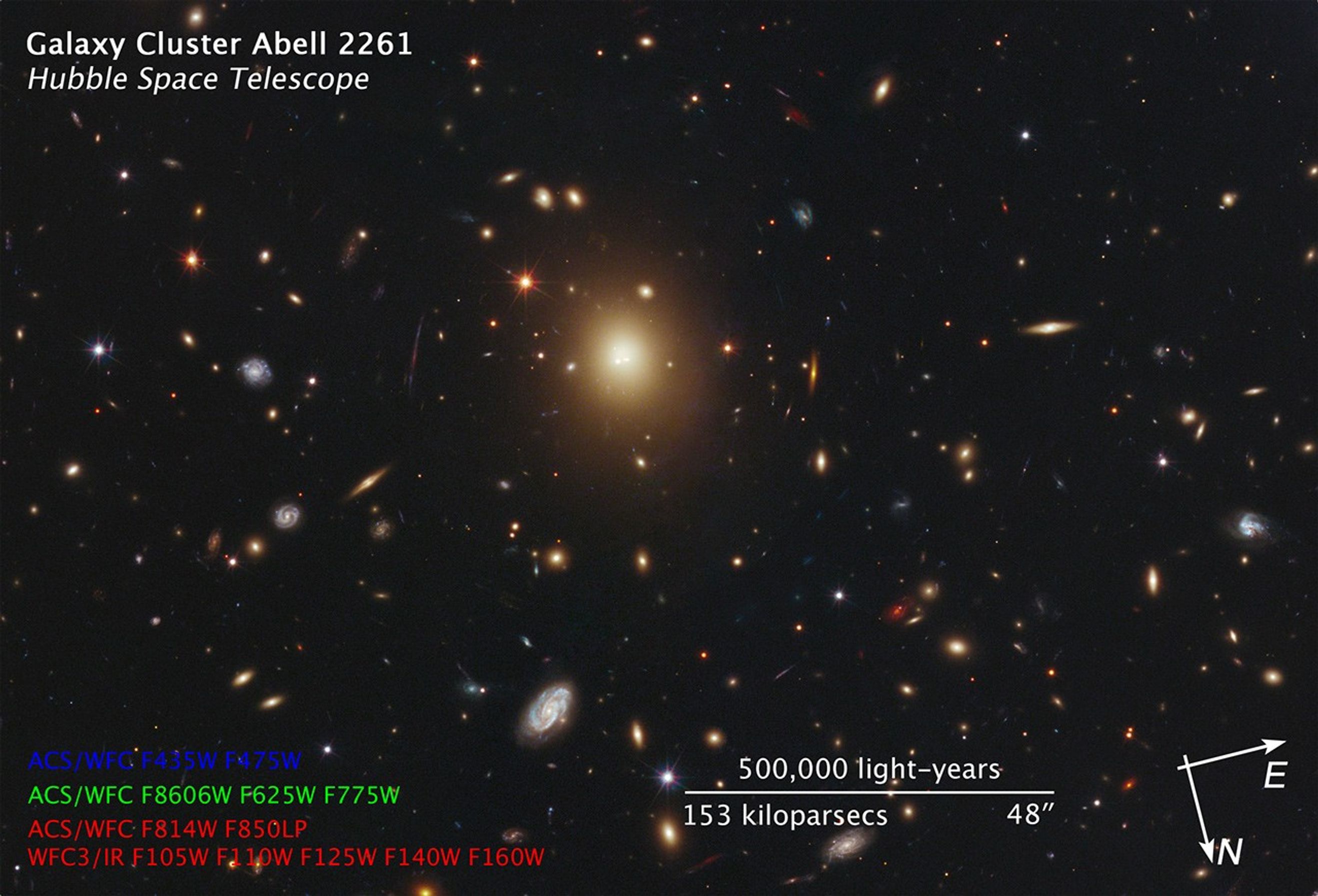1 min read
Monster Galaxy Lacks a Bright Core

The giant elliptical galaxy in the center of this image, taken by NASA's Hubble Space Telescope, is the most massive and brightest member of the galaxy cluster Abell 2261.
Spanning a little more than one million light-years, the galaxy is about 10 times the diameter of our Milky Way galaxy. The bloated galaxy is a member of an unusual class of galaxies with a diffuse core filled with a fog of starlight. Normally, astronomers would expect to see a concentrated peak of light around a central black hole. The Hubble observations revealed that the galaxy's puffy core, measuring about 10,000 light-years, is the largest yet seen.
The observations present a mystery, and studies of this galaxy may provide insight into how black hole behavior may shape the cores of galaxies.
Astronomers used Hubble's Advanced Camera for Surveys and Wide Field Camera 3 to measure the amount of starlight across the galaxy, dubbed A2261-BCG. Abell 2261 is located three billion light-years away.
The observations were taken March to May 2011. The Abell 2261 cluster is part of a multi-wavelength survey called the Cluster Lensing And Supernova survey with Hubble (CLASH).
About the Object
- R.A. PositionR.A. PositionRight ascension – analogous to longitude – is one component of an object's position.17h 22m 28.34s
- Dec. PositionDec. PositionDeclination – analogous to latitude – is one component of an object's position.32° 9' 12.66"
- ConstellationConstellationOne of 88 recognized regions of the celestial sphere in which the object appears.Hercules
- DistanceDistanceThe physical distance from Earth to the astronomical object. Distances within our solar system are usually measured in Astronomical Units (AU). Distances between stars are usually measured in light-years. Interstellar distances can also be measured in parsecs.3 billion light-years (920 megaparsecs)
About the Data
- Data DescriptionData DescriptionProposal: A description of the observations, their scientific justification, and the links to the data available in the science archive.
Science Team: The astronomers who planned the observations and analyzed the data. "PI" refers to the Principal Investigator.The image was created from Hubble data from proposal 12066: M. Postman (STScI) et al. - InstrumentInstrumentThe science instrument used to produce the data.HST>ACS/WFC, and HST>WFC3/IR
- Exposure DatesExposure DatesThe date(s) that the telescope made its observations and the total exposure time.March - May 2011, Exposure Time: 13 hours
- FiltersFiltersThe camera filters that were used in the science observations.ACS/WFC: F435W (B), F475W (g), F606W (V) + F625W (r) + F775W (i), F814W (I), and F850LP (z); WFC3/IR: F105W (Y), F110W (YJ), F125W (J), F140W (JH), and F160W (H)
- Object NameObject NameA name or catalog number that astronomers use to identify an astronomical object.Abell 2261, A2261-BCG
- Object DescriptionObject DescriptionThe type of astronomical object.Elliptical Galaxy
- Release DateOctober 25, 2012
- Science ReleaseMonster Galaxy May Have Been Stirred Up By Black-hole Mischief
- Credit

This image is a composite of separate exposures acquired by the ACS instrument. Several filters were used to sample various wavelengths. The color results from assigning different hues (colors) to each monochromatic (grayscale) image associated with an individual filter. In this case, the assigned colors are: Blue: ACS/WFC F435W (B) + F475W (g) Green: ACS/WFC F606W (V) + F625W (r) + F775W (i) Red: ACS/WFC F814W (I) + F850LP (z), WFC3/IR F105W (Y) + F110W (YJ) + F125W (J) + F140W (JH) + F160W (H)

Share
Details
Claire Andreoli
NASA’s Goddard Space Flight Center
Greenbelt, Maryland
claire.andreoli@nasa.gov































